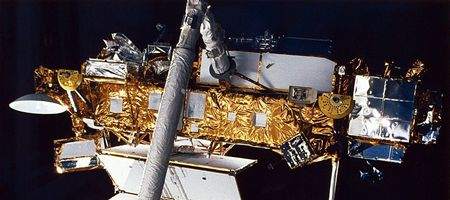Put on your hard hats, everybody: NASA’s warning that a defunct satellite is set to hit the earth sometime in the next six weeks.

The Upper Atmosphere Research Satellite (UARS) is expected to re-enter Earth’s atmosphere late this month or in early October, almost six years after it finished its mission.
It was launched on September 15, 1991, by the space shuttle Discovery. Originally designed for a three-year mission, UARS measured chemical compounds found in the ozone layer, wind and temperature in the stratosphere, as well as the energy input from the sun.
The 35-foot-long, 15-foot-diameter spacecraft was decommissioned on December 14, 2005.
Although it will break into pieces during re-entry, not all of it will burn up in the atmosphere, NASA warns. But, it says, there’s only a small risk to public safety or property. Anybody finding a piece of the space craft should avoid touching it, and should contact local law enforcement for help.
NASA doesn’t yet know exactly when UARS will re-enter – or where any pieces might hit. It plans to post weekly updates until four days before the anticipated re-entry, when it will switch to daily reports; as the moment nears, it will give even more information, it promises.
The problem is that the precise date of re-entry is hard to predict, as it depends on solar flux and the spacecraft’s orientation as its orbit decays. As the moment nears, though, predictions should become more precise.
As of yesterday, the orbit of UARS was 155 miles by 174 miles, with an inclination of 57 degrees. Because the orbit’s inclined 57 degrees to the equator, any wreckage will land somewhere between 57 degrees north and 57 degrees south. NASA estimates the debris footprint will be about 500 miles long.
If anybody does get hit by a piece, it’ll be a first. There’s never been a confirmed report of an injury from re-entering space objects, nor of significant property damage.






